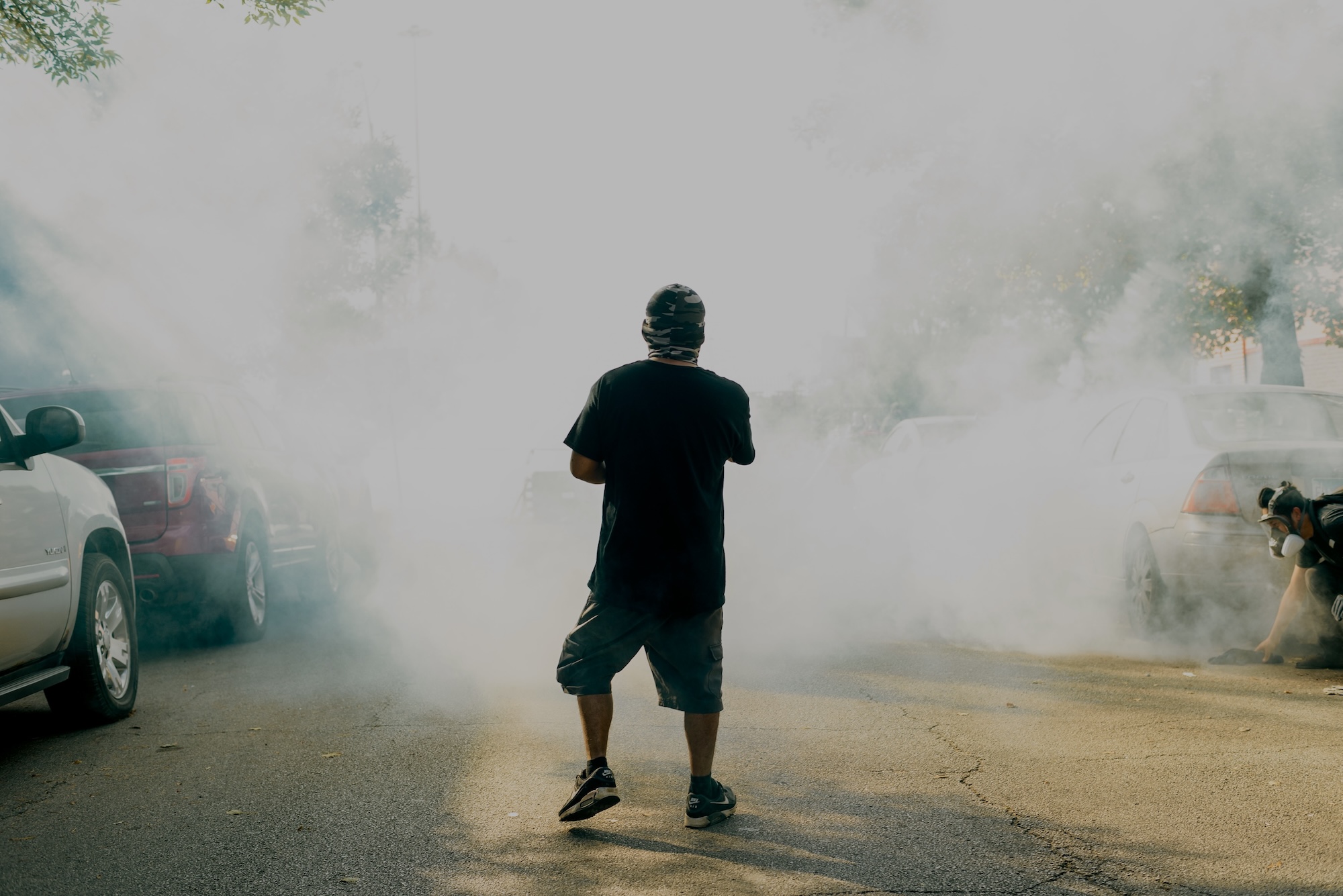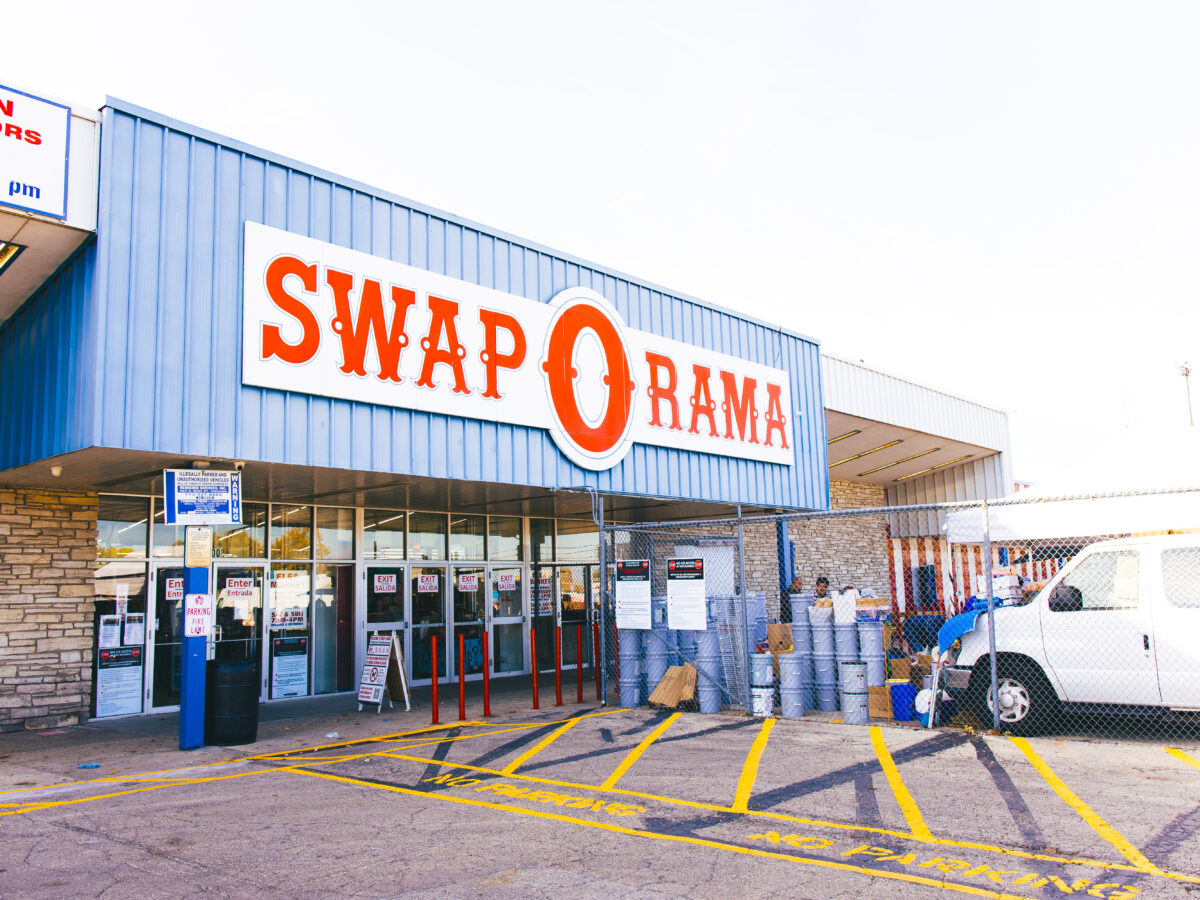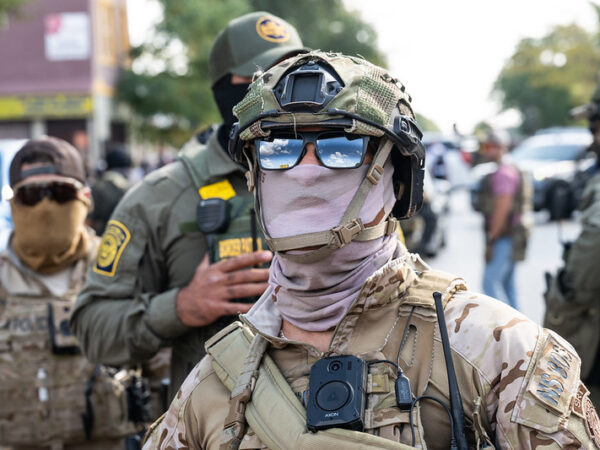This investigation was co-produced by Block Club Chicago, Cicero Independiente, the Investigative Project on Race and Equity, Invisible Institute, South Side Weekly, and The TRiiBE.
José* was inside his Brighton Park home with his wife María* and their pets on October 4 when the smell of tear gas overwhelmed him.
“The gas seeped in and we started choking, so I said, ‘[Get] the bird and the cat,’” María said in Spanish. (José and María are pseudonyms we are using due to concerns about retribution.)
Tear gas, thrown in the middle of a residential block by federal agents, seeped into their home through the air-conditioning vents and the old, unsealed windows. It quickly spread throughout the first floor, filling the living room, dining room and kitchen with toxic fumes.
“We couldn’t open the windows because the gas would get inside. We couldn’t go to the backyard. So, we hid in the back room,” María said.
Their house was among several in Brighton Park that were engulfed in tear gas after federal agents threw canisters during an hours-long standoff with Chicagoans.
Despite the lingering smell of tear gas, the family didn’t leave the house for two days. When they did, they found a tear gas canister on the front porch of their home.
“I had never felt such fear,” José said. “I’ve lived in Chicago for forty years, and it’s the first time I’ve seen anything like this. To live it firsthand, it feels awful.”
The tear gas that blanketed the block was part of an unprecedented wave of chemical weapons deployed on Chicago’s streets during Operation Midway Blitz. An investigation by a group of Chicago-area newsrooms and independent journalists found that federal agents used tear gas and pepper spray at least fifteen times in Brighton Park on October 4—more than the Chicago Police Department (CPD) has used all year.
None of the CPD’s uses involved protesters. The department says its officers haven’t used chemical weapons on demonstrators since 2021.
A close review of the October 4 protests shows federal agents repeatedly using tear gas and pepper spray, often appearing to escalate encounters with nonviolent protesters. Videos and photos show agents tossing tear gas from moving vehicles and deploying gas and pepper balls with little or no warning, even when protesters and bystanders posed no visible physical threat. Tear gas has been linked to long-term health problems. Experts also warn that the aggressive tactics by federal agents can create dangerous confrontations and threaten the free speech of Chicagoans.
A Department of Homeland Security (DHS) spokesperson later blamed the incident on demonstrators. DHS did not respond to a request for comment for this story.
The events of October 4 also helped establish a pattern of force by federal agents. Our investigation found that federal agents used chemical weapons on protesters at least 49 times across 18 incidents across Chicago and the suburbs since October 1. Federal agents have used chemical irritants at least thirty times since a judge placed restrictions on their use of tear gas and pepper spray. Contrary to federal claims about attacks on agents, most of these incidents appear to involve nonviolent protesters or bystanders.
Map credit: Maheen Khan and Jim Daley
The findings are based on videos and photos posted online or sent to a tip line organized by a group of nine local newsrooms and independent journalists. The review does not include chemical weapon uses from outside the federal ICE facility in Broadview, a western suburb, where agents have also repeatedly deployed tear gas and pepper balls.
On November 6, U.S. District Court Judge Sara L. Ellis issued an order forbidding federal agents from using riot control weapons, including tear gas, unless it’s necessary to stop someone from physically harming another person. The order is part of a lawsuit filed on behalf of Block Club Chicago and other media organizations, seeking to protect the First Amendment rights of journalists and peaceful protesters.
Since then, federal agents have used chemical weapons at least four times, including two cases where agents appeared to fire pepper spray out of a moving vehicle directly into another moving car, possibly violating both the injunction and Border Patrol rules restricting chemical weapon uses on motorists.

The protests that ended with tear gas wafting over houses in Brighton Park began that morning, when Border Patrol agent Charles Exum shot Marimar Martinez, a thirty-year-old Chicago resident and U.S. citizen, multiple times. Federal officials claimed that Martinez tried to ram agents with her car. Martinez’s attorney said during a court hearing that federal agents’ bodycam footage shows an agent turning their vehicle into Martinez’s before Exum exited his vehicle and shot her. As federal agents surrounded the scene of the shooting, a few dozen protesters faced off with a handful of federal agents in tactical gear at the intersection of 39th Place and Kedzie Avenue.
After a few minutes, a line of agents ordered protesters away from the scene of the shooting. Most began to move, but a lone protester stood his ground in the street. One agent shoved him and others reached for him as he struggled to escape, his shirt flying into the air during the scuffle.
As the man backpedaled away, an agent placed his pepper-ball launcher in the middle of the street, about a dozen feet from several onlookers. He then strode toward the protester.
Another agent ran forward and pulled the first agent back, then shot pepper balls at the feet of nearby protesters. Moments later, an agent fired projectiles toward the crowd as it retreated up the block.
The encounter, including the sudden deployment of chemical weapons on protesters, left people coughing and infuriated.
“Don’t f—ing touch people. Nobody touched you,” a woman yelled. “All that aggression for what?”
U.S. Department of Homeland Security Assistant Secretary Tricia McLaughlin told a Fox News host that the agents in Brighton Park were “surrounded by a violent crowd who began to throw bottles and rocks at our agents.”
Videos of the Brighton Park protests paint a different picture: they show federal agents initiating a confrontation with a vocal but nonviolent crowd. The confrontation at 39th Place and Kedzie Avenue appears to be the first time they used chemical weapons in Brighton Park.
All told, videos and photos from the Brighton Park protest show agents deploying tear gas and pepper balls at least fifteen times. Ten of the Brighton Park chemical weapon deployments appeared to target nonviolent protesters. Only three deployments occurred after objects were thrown toward agents. All three appeared to happen after agents had previously used chemical weapons against protesters.
Videos from the corner of Pershing Road and Kedzie Avenue show federal agents rolling tear gas grenades toward small groups of non-violent protesters at close range, including an agent who tosses tear gas at a man raising his hands in an apparent attempt at deescalation.
At 39th Place and Kedzie Avenue, at least three federal agents threw canisters at protesters, engulfing part of a residential block in tear gas. Photojournalist Daniel Delgado said only about two dozen peaceful demonstrators were at the intersection, and agents gave no warning before throwing the canisters. Delgado’s photos show Chicago police officers standing alongside federal agents as the agents used tear gas against protesters.
At least three incidents appear to involve agents tossing tear gas canisters from vehicles as they drove away. A video posted by journalist Dave Byrnes shows a canister igniting at the feet of a surprised onlooker, who screams and runs away.
César Cuauhtémoc García Hernández, an Ohio State University law professor who focuses on immigration law and police practices, said tossing canisters from moving cars poses real risks since “the person throwing the tear gas has very little ability to control where it’s going.” He added that the approach “is very indiscriminate. It’s going to affect whoever happens to be around, whether those are people who are protesting or not.”
Chet Epperson, a thirty-three-year police veteran and former Rockford police chief who now serves as a federal consent-decree monitor for New Orleans, said that each deployment of force should be investigated.
“Management of law enforcement needs to look at every one of these deployments and ask itself: Was it necessary? Was it proportional? Was it under the Constitution? Was it by department policy? And are there alternative methods we could have deployed?” he said.
It’s unclear whether the tear gas deployments triggered any such review. Agents have operated under a temporary restraining order limiting their use of riot control weapons since October 9, but lawyers for the plaintiffs in the lawsuit claim that federal agents have repeatedly violated the order.
The majority of the chemical weapon deployments reviewed by reporters occurred after the restraining order went into effect. Most appeared to target nonviolent protesters, including tear gas deployments in Lakeview, Avondale, and Albany Park.
Altogether, reporters gathered and reviewed forty-nine uses of tear gas and other chemical weapons since the start of October. Of these, two-thirds appear to have targeted peaceful demonstrators or bystanders. Only six clearly show objects being thrown toward federal agents immediately before they respond with tear gas; the remaining cases are inconclusive.
In an interview with CBS, Border Patrol Chief Greg Bovino has called his agents’ use of force “exemplary” and declared that “If someone strays into a pepper ball, then that’s on them. Don’t protest and don’t trespass.”

Judge Ellis found that Bovino lied about his use of tear gas, saying that he had “admitted that he lied about whether a rock hit him before he deployed tear gas in Little Village.”
Federal agents’ use of chemical agents stands in stark contrast to the Chicago Police Department, which regularly handles protests and crowds without resorting to similar tactics.
One major difference is that the CPD policy sharply limits the use of tear gas and pepper spray on people who are protesting, typically requiring both the threat of violence and the approval of the superintendent. University of Chicago law professor Craig Futterman, who helped negotiate the current policy after CPD faced criticism for their use of pepper spray on protesters in 2020, said the limits are in place “to protect the First Amendment rights of people to protest, to voice dissent, to report, [and] to assemble.”
Even the threat of violence from a member of the crowd does not automatically mean senior officials will authorize chemical weapons, said Futterman, who points to the risk of hurting “people who have done nothing wrong, who pose no threat to anyone” and concerns that indiscriminate chemical weapon deployments can escalate confrontations, driving people to fight back.
“Throughout the past few years, CPD has successfully secured numerous large-scale demonstrations, including those related to the war in Gaza and the 2024 Democratic National Convention,” a Chicago police spokesperson said in an email. “Our responses to First Amendment assemblies are guided by our First Amendment Rights policy, which is rooted in fair, impartial and constitutional policing.”
Many federal agents operate under less restrictive rules. Border Patrol force guidelines released as part of ongoing litigation against the Department of Homeland security show that agents are allowed to use tear gas and pepper spray against people actively resisting them.
Pepper Spray & Tear Gas: Here’s How to Spot the Difference — Borderless Magazine
The use of chemical weapons in Brighton Park left a mark on participants and neighbors alike. For a few days, José and María had skin rashes and discomfort, which they believe was an effect of their exposure to the chemical agent. Meanwhile, Delgado, the photographer, said his throat felt scratchy for several days after he was affected by tear gas.
“The main thing with tear gas is that iIt’s a pretty indiscriminate weapon,” said Rohini Haar, an emergency physician and medical adviser for Physicians for Human Rights, which studies the health impacts of crowd-control weapons such as tear gas. “You can’t say, ‘Oh, I’m only trying to hit this one individual.’ Everybody disperses.” Once deployed, “it aerosolizes, it goes into the air, and then it kind of targets everybody in that space.”
The effects can be immediate and severe: burning eyes and skin, coughing and suffocation.
“It hurts a lot more than you think it does,” Haar said. “Especially when you’re exposed to too much or you’re not able to get out because you’re in an enclosed space.”
For children and pregnant people, the risks are higher. “Children have more fragile skin,” she said. “They also have more skin per body weight, so they just have more spaces to get exposed.” There have been “case reports of miscarriage and complications, especially with overuse of tear gas.”
Although international standards such as the U.N. Basic Principles on the Use of Force outline the need for necessity, proportionality and precaution, they are rarely enforced.
“By and large, these weapons are highly unregulated,” Haar said. “No one’s regulating the manufacturer, how they’re made, what the concentration of it is in there.”
Residents across the Chicago area are now confronting the effects of chemical weapons. After federal agents used tear gas in Logan Square, Julia Cary went to help people hit by the cloud of gas. She said two of the hardest-hit victims were a couple who were driving nearby when their car was engulfed by the cloud of gas. Cary said the pair struggled to open their eyes, and she needed to peel back their eyelids to flush their eyes with liquid. The same deployment also caught a couple walking home from school with their two-year-old.
Federal agents have been operating under a temporary injunction that limits their ability to use chemical weapons on protesters and journalists since November 6. Reporters reviewed four instances of agents using pepper spray or tear gas since the injunction was issued.
Two videos from November 8 show agents using chemical weapons in ways that appear to violate both the injunction, which only allows agents to use pepper spray if there is an “immediate threat of physical harm,” and current Border Patrol rules, which restrict their use against children, older people, and people driving cars.
One video shows federal agents deploying pepper spray into a family’s car in Cicero, hitting a man with asthma and his one-year-old daughter.
Another clip provided to reporters shows agents pulling alongside a moving vehicle on Roosevelt Avenue and apparently firing pepper spray at the occupants before speeding off. Neither video shows any visible threat to agents before their use of pepper spray.
Uses of force that appear to violate both agency rules and judicial orders could create a dangerous situation, one expert warned.
“What they’re doing is creating a whole lot of ill will with local communities,” said García Hernández, noting that Department of Homeland Security agents appear intent on using tactics that escalate confrontations. “And right now that is mostly manifesting as an organized, peaceful resistance. I hope it remains that way.”
You can help us report on the use of force by federal agents. Submit tips at our tip line. The tip form is monitored by journalists from Block Club Chicago, Borderless, the Chicago Reader, Cicero Independiente, Invisible Institute, the Investigative Project on Race and Equity, Lumpen Radio, South Side Weekly, and The TRiiBE.
After ICE Raid, Swap-O-Rama Vendors Push for Safety
A chaotic federal raid left vendors at the longtime South Side flea market shaken. Now they’re demanding stronger protections.
Lawsuit Alleges Inhumane Conditions at Broadview ICE Facility
Federal authorities moved two plaintiffs in the suit out of state; a judge has ordered they be returned Monday.
Cook County Board Reapproves Contract with ICE-Linked Data Firm as Raids Sweep Chicago
Four years after first being warned that a contract risked exposing immigrant data to ICE, Cook County approved another renewal—this time with advocates commissioners voicing frustration that stronger safeguards are still missing.




